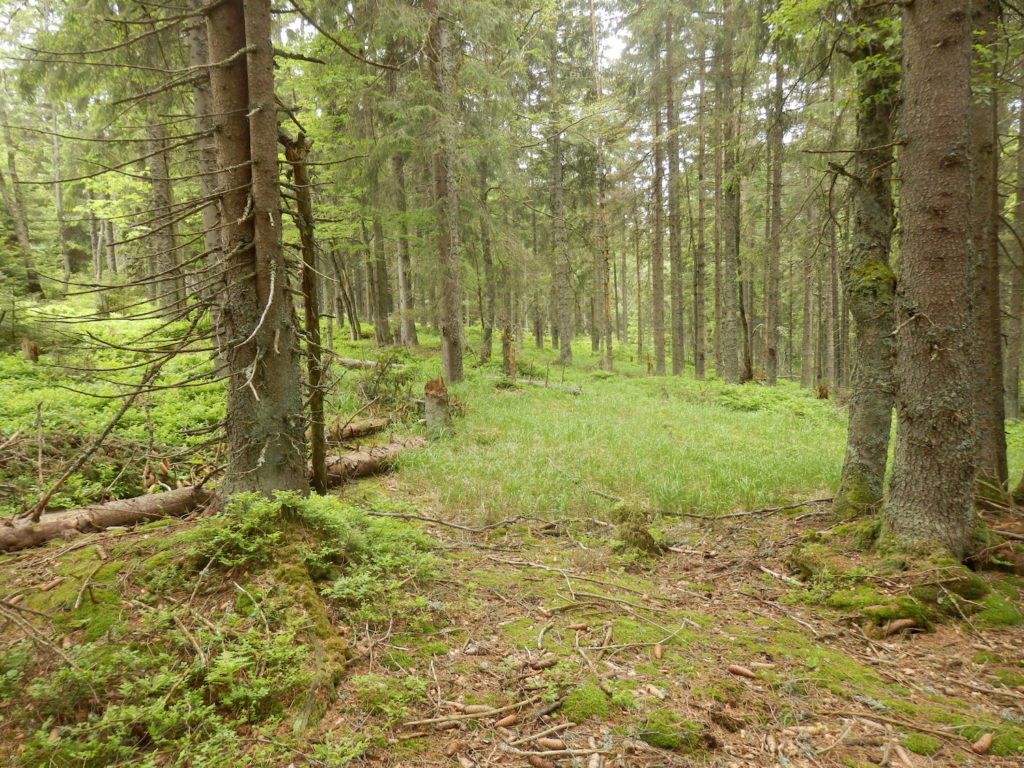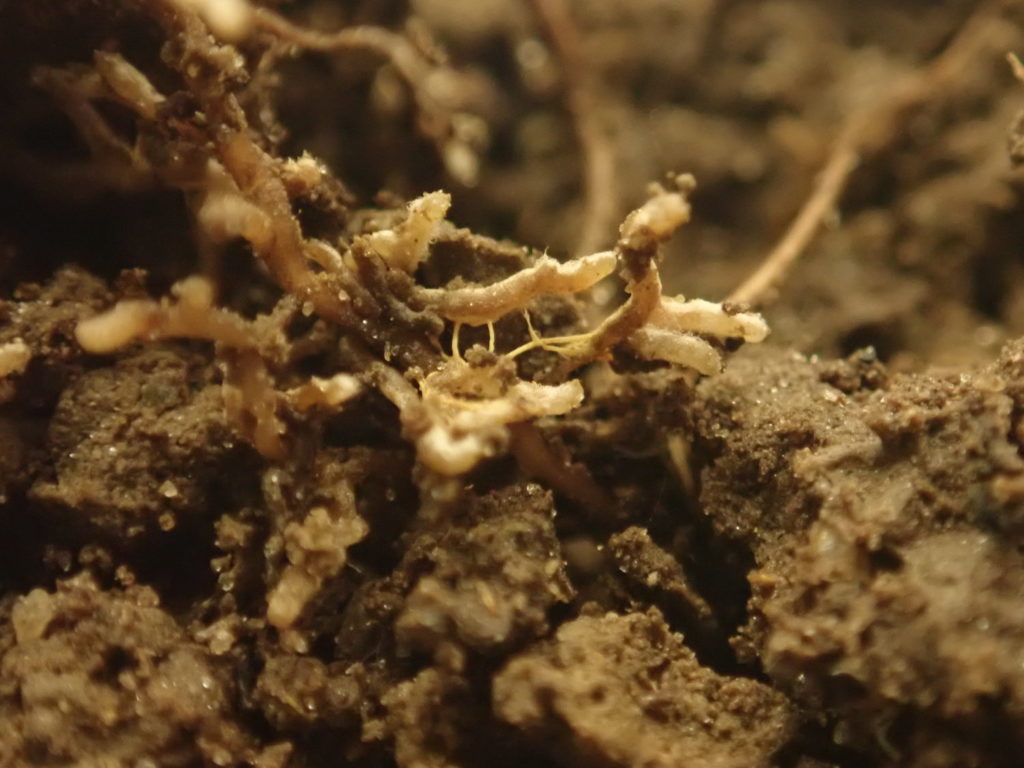Bacterial enzymes play second fiddle to those from fungi when it comes to breaking down tough plant fibers.

The study site in the coniferous forest, located in Bohemian Forest National Park, Czech Republic. (Petr Baldrian)
The Science
Walk in a temperate forest filled with Norway spruce trees, and microbial activity teems beneath your feet. Both bacteria and fungi have genes that can break down plant fibers. But are they both actually doing the job? By analyzing the enzymes present in the complex organic matrix of the forest floor, a team of researchers have found that there is a striking division of labor between the two groups. Fungi are much more active in degrading plant matter, and bacteria are more active in fixing and metabolizing nitrogen, a key ecosystem nutrient.
The Impact
This study is the first to dig into a forest floor ecosystem to discover what carbon- and nitrogen-metabolizing enzymes are abundant, and to which microbes they belong. This study provides further insights into the microbial involvement in carbon and nitrogen cycling and forest floor ecosystem processes. Pinpointing the processes happening on and in forest soil also better enriches models of global carbon and nitrogen cycling, both on the ground and what escapes to the atmosphere in the form of greenhouse gases (e.g., carbon dioxide, methane, and nitrous oxide).
Summary

Roots of forest trees colonized by symbiotic ectomycorrhizal fungi that provide nutrients to their plant host. (Tijana Martinovic)
To do this work, the international scientific team led by Petr Baldrian of the Czech Academy of Sciences first needed to build a detailed database on the denizens in the soil. While large protein databases, like UniProt, exist, are not specific enough for a microbial community like that from a temperate coniferous forest floor — which Baldrian’s team was investigating.
So, to be able to identify proteins, the team compiled DNA sequences (metagenomes) and messenger RNA sequences (transcriptomes) from their soil samples. This gene expression dataset was particularly important for characterizing fungal genes, because, unlike bacteria, they often carry interrupting sequences, called introns. Introns are like having extra words squished into a sentence. The transcriptomes edit out these distractions. Combining genome and transcriptome information allowed the team to have a much more comprehensive picture of microbial genes in the soil and to which type of microbe they belonged.
The team worked with the U.S. Department of Energy (DOE) Joint Genome Institute (JGI), a DOE Office of Science User Facility located at Lawrence Berkeley National Laboratory, to create the database. JGI provided metagenome and metatranscriptome sequences, as well as individual reference fungal genome sequences assembled as part of its 1000 Fungal Genomes Project.
To map microbial activity, Baldrian’s team distinguished four specific habitats within the forest floor: the leaf litter on top of the soil, the roots of the trees, the rhizosphere soil (soil under direct influence of the roots), and the remaining soil (further from the roots). The team collected samples from these habitats.
The proteins in the samples were then isolated and sequenced by scientists at the Environmental Molecular Sciences Laboratory (EMSL), a DOE Office of Science user facility at Pacific Northwest National Laboratory. Analyzing the collection of proteins (the proteome) and referencing the database, Baldrian’s team was able to identify enzymes in the soil and who made them.
Based on data reported in the April issue of Soil Biology and Biochemistry, the team found that fungi are playing a bigger role in soil decomposition processes than expected. The transcriptome data had suggested about a 50/50 split between fungal and bacterial enzymes. Yet, they found proteomic data told a different story: fungal enzymes actually outnumbered bacterial enzymes 3-to-1. Additionally, the fungal enzymes the team found suggest that fungi are breaking down plant fibers, like cellulose and lignin. Bacteria, on the other hand, appear to be ignoring these difficult potential foodstuffs.
The team’s findings also illustrate what’s happening on a spatial scale. Breaking down plant matter by fungi is happening much more in the leaf litter and soil near the roots. But the deeper down and away from the roots one goes, the more bacteria show up.
The data underscore what was already suspected: these microbial groups play different roles in a healthy, forest soil ecosystem. Bacteria are playing an important role that fungi can’t fulfill by fixing nitrogen and using it as an energy source. No fungi are known to be able to do this.
JGI and EMSL’s contributions were enabled by the Facilities Integrating Collaborations for User Science (FICUS) initiative, which allows researchers to integrate the expertise and capabilities of more than one DOE Office of Science National User Facility, with the stroke of a single proposal.
Contacts:
BER Contact
Ramana Madupu, Ph.D.
Program Manager
Biological Systems Sciences Division
Office of Biological and Environmental Research
Office of Science
US Department of Energy
Ramana.Madupu@science.doe.gov
BER Contact
Paul Bayer, Ph.D.
Program Manager
Earth and Environmental Systems Sciences Division
Office of Biological and Environmental Research
Office of Science
US Department of Energy
paul.bayer@science.doe.gov
PI Contact
Petr Baldrian, Ph.D.
Institute of Microbiology, The Czech Academy of Sciences
baldrian@biomed.cas.cz
Funding:
This work was supported by the Czech Science Foundation (18- 25706S and 20-02022Y), by the Ministry of Education, Youth and Sports of the Czech Republic (LTT17022). A portion of this research was per- formed under the Facilities Integrating Collaborations for User Science (FICUS; #49499) program and used resources at the DOE Joint Genome Institute and the Environmental Molecular Sciences Laboratory (grid.436923.9), which are DOE Office of Science User Facilities. Both facilities are sponsored by the Office of Biological and Environmental Research and operated under Contract Nos. DE-AC02-05CH11231 (JGI) and DE-AC05-76RL01830 (EMSL).
Publication:
- Starke R et al. “Niche differentiation of bacteria and fungi in carbon and nitrogen cycling of different habitats in a temperate coniferous forest: A metaproteomic approach.” Soil Biology and Biochemistry. 155,108170 (2021). doi: 10.1016/j.soilbio.2021.108170
Related Links:
- Facilities Integrating Collaborations for User Science (FICUS) program
- Petr Baldrian’s project proposal is part of the 2016 FICUS collaborative science portfolio
- JGI Fungal & Algal Program
- About JGI’s Genomic Encyclopedia of Fungi project
- EMSL’s Integrated Research Pathway (IRP): Biomolecular Pathways
- EMSL’s Instruments & Resources
- Advanced two-dimensional protein separation technique developed by EMSL scientists
Byline: Alison F. Takemura